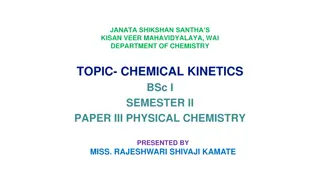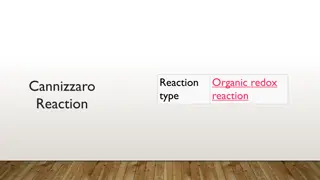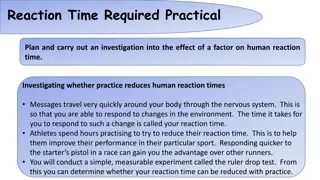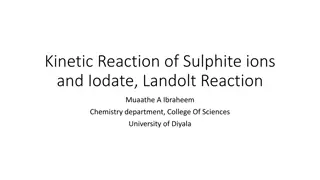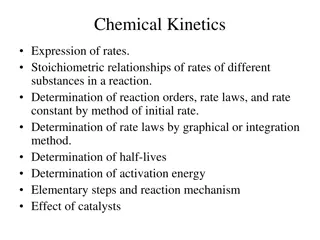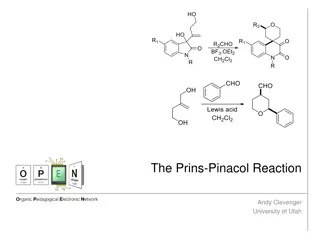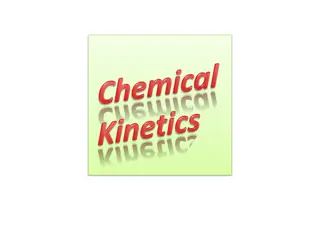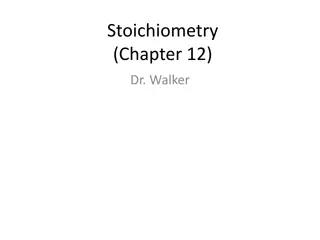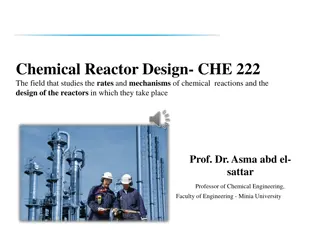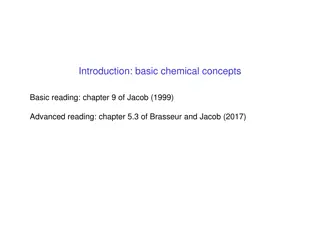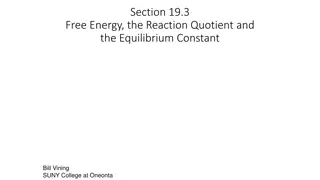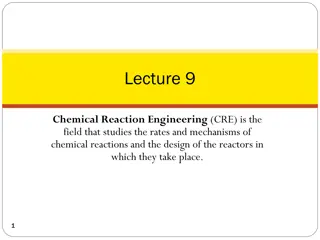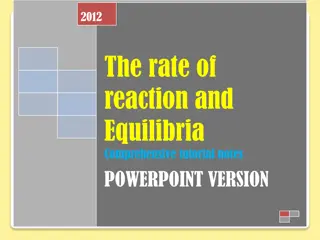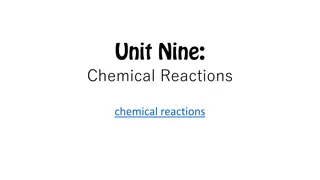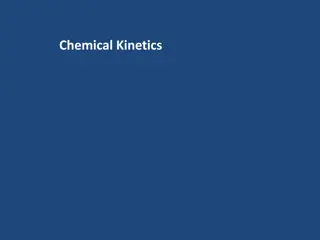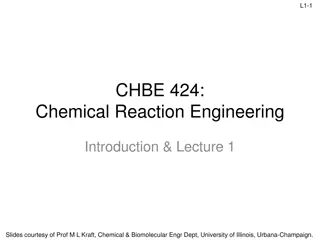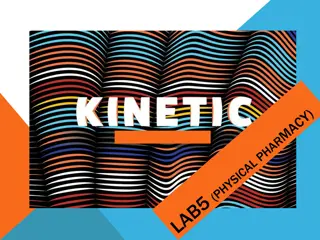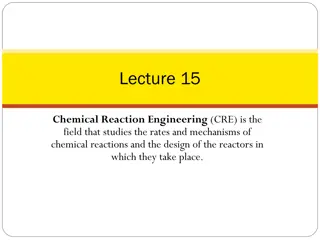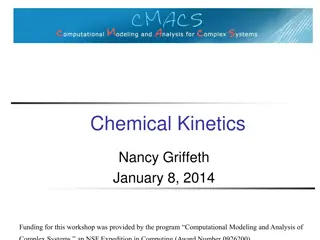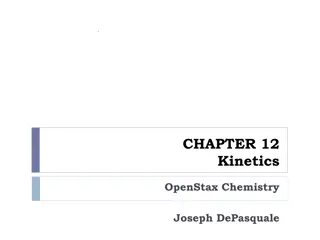
Chemical Reactions and Their Types Explained
Explore the different types of chemical reactions such as combination, decomposition, displacement, and double displacement reactions. Understand how atoms transform during reactions and the bonds involved in producing new substances. Witness an activity demonstrating the reaction of quicklime (Calcium Oxide) with water. Learn about the production of slaked lime (Calcium Hydroxide) and its use in forming Calcium Carbonate. Discover the chemical formulas and reactions involved in these processes.
Download Presentation

Please find below an Image/Link to download the presentation.
The content on the website is provided AS IS for your information and personal use only. It may not be sold, licensed, or shared on other websites without obtaining consent from the author. If you encounter any issues during the download, it is possible that the publisher has removed the file from their server.
You are allowed to download the files provided on this website for personal or commercial use, subject to the condition that they are used lawfully. All files are the property of their respective owners.
The content on the website is provided AS IS for your information and personal use only. It may not be sold, licensed, or shared on other websites without obtaining consent from the author.
E N D
Presentation Transcript
We reaction change Nor mixture We have reaction atoms change into Nor do mixture or have learnt atoms of into those do atoms or appear learnt that that during of one those of atoms disappear appear from during a a chemical one element of another disappear from from elsewhere chemical do not element. . from the element do another element not the elsewhere. . Actually breaking atoms Actually, , chemical breaking and atoms to chemical reactions and making to produce reactions involve making of produce new involve the bonds between new substances the of bonds substances. . between
1. Combination Reactions 2. Decomposition Reactions 3. Displacement Reactions 4. Double Displacement Reactions
Activity Activity Take or Take a a small or Quick small amount Quick Lime amount of Lime in of Calcium beaker. . Calcium Oxide Oxide in a a beaker Slowly Slowly add add water water to to this this. . Touch Do Touch the Do you the beaker you feel beaker feel any any change change in in temperature? temperature?
Calcium produce releasing Calcium Oxide produce slaked releasing a a large CaO Oxide reacts slaked lime large amount CaO(s (s) ) + + H H2 2O(l) reacts vigorously lime (Calcium amount of O(l) vigorously with (Calcium Hydroxide of heat Ca with water Hydroxide) ) water to to heat. . aq) ) +heat Ca(OH) (OH)2 2( (aq +heat ( (Quick Quick lime) lime) ( (Slaked Slaked lime lime) ) In combine Hydroxide In this combine to Hydroxide. . this reaction, to form reaction, Calcium form a a single Calcium Oxide single product Oxide and product, , Calcium and water Calcium water Such formed a a combination Such a a reaction formed from combination reaction reaction in from two in which two or reaction. . which a a single or more single product reactants is is known product is is known as more reactants as
A A solution used reacts thin solution of used for reacts slowly thin layer of slaked white washing slowly with layer of slaked lime washing walls with the of Calcium lime produced walls. . Calcium the Carbon Calcium Carbonate by the Calcium hydroxide dioxide in Carbonate on produced by the reaction hydroxide in air on the reaction is is for white Carbon dioxide air to walls. . to form form a a the walls Calcium of walls Calcium Carbonate of white walls. . Carbonate is is formed white washing formed after and gives after two shiny finish two to to three finish to three days to the days the washing and gives a a shiny It It is is interesting marble interesting to marble is is also to note CaCO3 3. . note that that the the chemical chemical formula formula for for also CaCO Ca(OH) Calcium Ca(OH)2 2(aq (aq) + CO ) + CO2 2(g) CaCO (g) CaCO3 3(s) + H ( (Calcium (s) + H2 2O(l) Calcium O(l) Hydroxide) Carbonate ( (Calcium Hydroxide) Carbonate) )
(i) Burning of coal C(s) + O2(g) CO2(g) (ii) Formation of water from H2(g) and O2(g) 2H2(g) + O2(g) 2H2O(l) In simple language we can say that when two or more substances (elements or compounds) combine to form a single product, the reactions are called combination reactions.
we evolved This Reactions the exothermic Other (i) CH (ii) exothermic we also evolved when This makes Reactions in the exothermic chemical Other examples (i) Burning CH4 4(g) (ii) Do exothermic process? observed that we add the reaction in which formation chemical reactions examples of Burning of (g) + + 2 2O O2 2 (g) Do you process? also observed when we makes the that a a large add water reaction mixture which heat formation large amount water into mixture warm heat is is released of reactions. . of exothermic of natural (g) you know amount of into Quick warm. . released along products of heat Lime . . heat is is Quick Lime along with are with called of products are called exothermic reactions natural gas CO know that reactions are are gas (g) + + 2 2H H2 2O O (g) that respiration CO2 2 (g) (g) respiration is is an an
We We During simpler For . . These form This of We all We get During digestion, simpler substances For example, These carbohydrates form glucose This glucose of our all know get this digestion, food substances. . example, rice, carbohydrates are glucose. . glucose combines our body know that this energy that we energy from food is is broken we need need energy from the energy to the food broken down to stay food we down into stay alive we eat alive. . eat. . into rice, potatoes potatoes and and bread bread contain are broken contain Carbohydrate broken down Carbohydrate. . down to to combines with body and with oxygen energy. . oxygen in in the the cells cells and provides provides energy C C6 6H H12 12O O6 6(aq) (aq)+ + 6 6O O2 2(aq) (aq) 6 6CO CO2 2(aq) (aq)+ + 6 6H H2 2O O(l) (l)+ + energy energy
(iii) The decomposition of vegetable matter into compost is also an example of an exothermic reaction. Identify the type of the reaction taking place in Activity where heat is given out along with the formation of a single product. 2Mg + O2 2MgO
Activity Take dry Note crystals Heat burner Observe heating Take about dry boiling Note the crystals. . Heat the burner or about 2 2 g g ferrous boiling tube the colour ferrous sulphate sulphate crystals crystals in in a a tube. . colour of of the the ferrous ferrous sulphate sulphate the boiling or spirit boiling tube spirit lamp tube over lamp as over the as shown the flame in Fig flame of Fig. . of a a shown in Observe the heating the colour colour of of the the crystals crystals after after
Have you noticed that the green colour of the ferrous sulphate crystals has changed? You can also smell the characteristic odour of burning Sulphur.
In reactant products Ferrous water crystals ferric and Ferric gases In this reactant products. . This Ferrous sulphate water when crystals changes ferric oxide and sulphur Ferric oxide gases. . this reaction reaction we breaks This is is a a Decomposition sulphate crystals when heated changes. . It It then oxide (Fe sulphur trioxide oxide is is a a solid can observe down Decomposition reaction crystals (FeSO heated and then decomposes (Fe2 2O O3 3), ), sulphur trioxide (SO solid, , while we can observe that down that a a single give reaction. . (FeSO4 4, , 7 7H H2 2O) and the decomposes to sulphur dioxide (SO3 3) ). . while SO single simple breaks to to give simple O) lose of the lose the to (SO2 2) ) the colour colour of dioxide (SO SO2 2 and and SO SO3 3 are are
Decomposition calcium is is an in Calcium It It has of When out decomposition Decomposition of calcium oxide an important in various Calcium oxide has many of cement When a a decomposition out decomposition. . CaCO ( (Limestone) of calcium and carbon decomposition reaction various industries oxide is is called many uses cement. . decomposition reaction by CaCO3 3(s (s) ) Limestone) calcium carbonate carbon dioxide carbonate to dioxide on reaction used to oxide and important decomposition industries. . called lime uses one on heating heating used lime or in the or quick the manufacture quick lime manufacture lime. . one is is in reaction is is carried is is He ( (Quick carried thermal )+ CO Quick lime by heating, heating, it it called at called CaO thermal CO2 2(g) lime) ) He at CaO(s (s)+ (g)
Take Hold heat What Note We These The Take about about 2 2 g g lead lead nitrate nitrate powder powder in in a a boiling boiling tube tube. . Hold the heat it it over What do Note down We will These fumes The reaction the boiling over a a flame, do you down the will observe fumes are reaction that boiling tube flame, as you observe the change observe the are of that takes tube with as shown observe? ? change, , if if any the emission of nitrogen takes place with a a pair shown in pair of in Fig of tongs Fig. . tongs and and any. . emission of nitrogen dioxide place is is of brown dioxide (NO brown fumes (NO2 2) ). . fumes. .
Take and Insert Connect Fill Add a few Take them Switch undisturbed Take a a plastic and fit Insert carbon stoppers Connect these Fill the electrodes Add a few drops of Take two them over Switch on undisturbed for plastic mug fit rubber carbon electrodes stoppers as these electrodes the mug electrodes are drops of dilute two test over the on the for some mug. . Drill stoppers in electrodes in as shown electrodes to mug with are immersed dilute sulphuric test tubes the two the current some time two holes these holes these rubber in Fig to a a 6 6 volt with water immersed. . sulphuric acid to the water. tubes filled two carbon current and time. . Drill two in these in these shown in holes at holes. . rubber at its its base base rubber stoppers Fig. . volt battery that the battery. . the water such such that acid to the water. filled with carbon electrodes and leave with water electrodes. . leave the water and and invert invert the apparatus apparatus
Is the volume of the gas collected the same in both the test tubes? Once the test tubes are filled with the respective gases, Test these gases one by one by bringing a burning candle test tubes. CAUTION: by the teacher. What happens in each case? Which gas is present in each test tube? Is the volume of the gas collected the same in both the test tubes? Once the test tubes are filled with the respective gases, remove them Test these gases one by one by bringing a burning candle close to test tubes. CAUTION: This step must be performed carefully by the teacher. What happens in each case? Which gas is present in each test tube? remove them carefully. carefully. close to the mouth of the the mouth of the This step must be performed carefully
Take about 2 g silver chloride in a china dish. What is its colour? Place this china dish in sunlight for some time Observe the colour of the silver chloride after some time.
We grey decomposition and Silver bromide also behaves in the same way. 2AgBr(s) The above reactions are used in black and white We will grey in decomposition of and chlorine 2 2AgCl see that sunlight. . This of silver chlorine by AgCl(s (s) ) will see in sunlight white silver This is is due silver chloride by light Sunlight 2 2Ag that white silver chloride chloride turns due to chloride into turns to the into silver the silver light. . Sunlight Ag(s) (s) + + Cl Cl2 2(g (g) ) Sunlight 2Ag(s) + Br2(g) Sunlight The above reactions are used in black and white photography photography
We reactions heat, the We have reactions require heat, light the reactants have seen require energy light or reactants. . that the energy either or electricity seen that the decomposition either in electricity for decomposition in the for breaking the form breaking down form of down of Reactions known Reactions in known as in which as endothermic which energy endothermic reactions energy is is absorbed reactions. . absorbed are are
Take tube with Touch the bottom of the test tube with your palm. What do you feel? Is Take about tube. . Add with the about 2 2 g g barium Add 1 1 g g of the help barium hydroxide of ammonium help of hydroxide in chloride and glass rod in a a test and mix test mix ammonium chloride of a a glass rod. . Is this an exothermic or this an exothermic or endothermic reaction? endothermic reaction?
1 1. . A A solution white (i) formula (ii) named 2 2. . Why of amount solution of white washing (i) Name formula. . (ii) Write named in Why is is the of the amount collected Name of a a substance substance X X is is used used for for washing. . Name the the substance substance X X and and write write its its Write the in (i) the reaction (i) above the amount the test collected in Name this reaction of above with amount of test tubes of the water. . of gas in Activity in the this gas the substance substance X X with water gas collected Activity double the other gas. . collected in double of other? ? in one of the one the tubes in
FOR MORE QUERIES: YOU CAN LOG IN TO WEBSITE www.scienceeasylearning.wor dpress.com YOU CAN ALSO LIKE MY FB PAGE THAT IS: KKCHAUHAN

